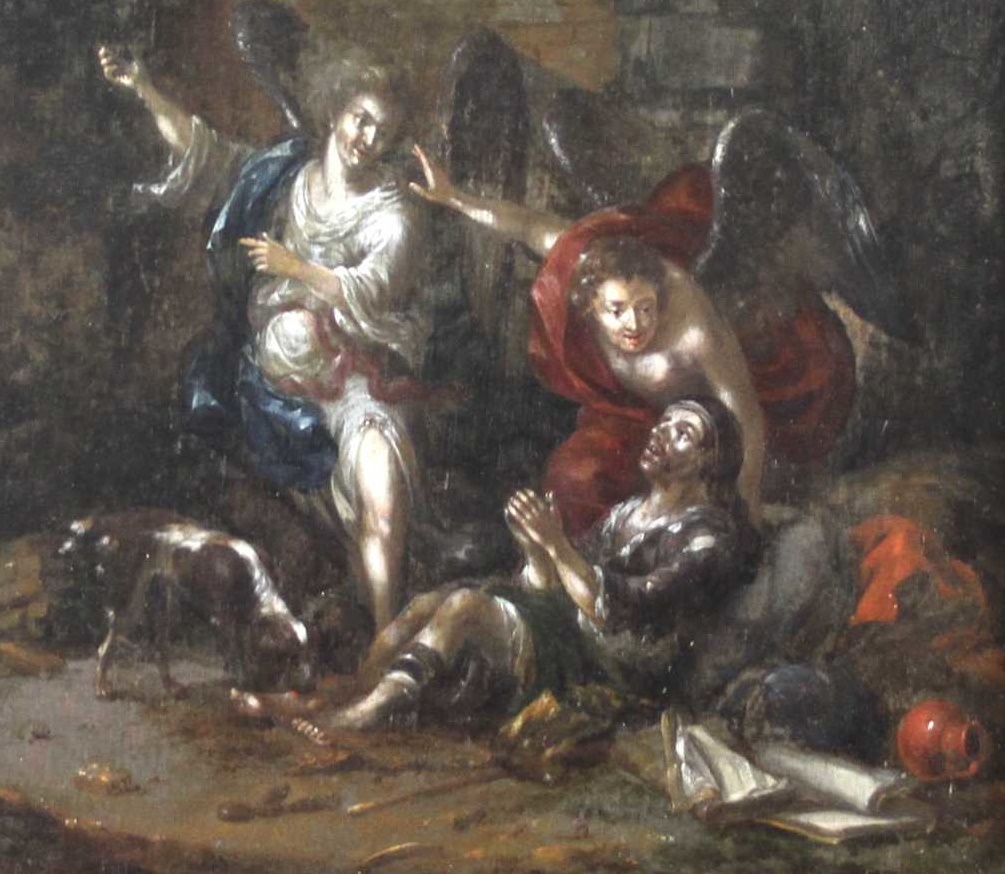Fresh to market 17th century biblical oil coming to auction
Our 16th September Fine Art & Antiques auction includes an intriguing painting, which has been subject to extensive research by the vendor.

It is a circa 1675 Dutch/Flemish study of a scene from the parable of Lazarus & The Rich Man in the book of Luke (not to be confused with the Lazarus who Jesus raised from the dead). This parable is commonly artistically portrayed as two settings showing the differing experiences of the rich man and the poor man Lazarus, both in life and their reception into the afterlife. However, this image is interesting because it solely shows Lazarus on the point of death and being ushered to heaven by angels – the rich man is nowhere to be seen. Other works on the parable show the comparable scenes or Lazarus being raised to heaven, but not the in-between happening. Therefore, it is supposed that this painting is possibly a preparatory sketch or study, which may be part of a larger work as yet unearthed.
The painting was discovered last year on a farmstead in South Africa, wrapped in a horse blanket within an old trunk. It was understandably in quite poor condition with varnish ‘blooming’, however careful restoration by conservator Rebecca Leathley has removed this superficial effect. The painting has been further examined by renowned dendrochronologist Dr Ian Tyers, who has dated the latest ring of the oak tree which produced the panel as 1663. How it came be in a South African trunk is a matter of pure conjecture, but many Dutch settlers made their way to Cape Town and surroundings as part of the Dutch East India Company’s colonization in the late 17th century. By 1691, there were at least 660 Dutch people living at the Cape of Good Hope. This had increased to about 13,000 by the end of Dutch rule, or one half of the Cape's European population. It is tempting to imagine the experience of these early settlers who took what they could safely carry; clothes, cooking utensils, essential tools and a Bible – it was perhaps the only book they possessed. With that, often wrapped in protective muslin, a devotional item would be found; a crucifix, a carving of the Madonna and Child, or a small painting – something inspirational, a talisman and reminder of the power of their faith, a constant source of narrative from which endless stories might be spun on those long lonely nights aboard ship or huddled together under canvas in the country that awaited them.

The story of Lazarus is subject to much debate in itself; he is the only person actually named in a parable which has led some to believe the story is based on a real event. There are also details which are illustrated in this painting which gives pause for thought, such as the sympathetic dogs licking Lazarus’s wounds (dog spittle was believed to have healing properties and has since been discovered to be an antiseptic), the upturned pitcher (possibly a symbol of spiritual anointment), and the open books (perhaps portraying authority of the scriptures and power of knowledge).
Many Dutch religious paintings, like Rembrandt’s emotionally evocative renditions of New and Old Testament stories for example, were meant for private display and contemplation. Hidden away from view therefore, and thus immune from historical record and scholarship over time, countless hundreds of centuries-old religious works of art remain undocumented even to this day. Did the present work ever actually spawn anything much grander, or should it be seen simply as a stand-alone reminder of a Golden Age? If, as it has been suggested, the present work is in fact a preparatory sketch or study, there is presently no evidence to suggest that a subsequent commission was ever forthcoming. And if there was, its whereabouts remain a mystery. Nevertheless there is no doubting the fact that the present work, humble as it may be, not only took on a life and a journey all of its own, but survived.
Further research by the vendor can be seen on Lacy Scott & Knight’s website https://www.lskauctioncentre.co.uk/lazarus/ . The painting is lot 2384 in the 16th September Fine Art & Antiques auction and carries an estimate of £1,500-2,000.
Sign up to hear about forthcoming auctions, news and featured lots
Please be assured that we will never pass your details on to third parties and you can unsubscribe at any point.
